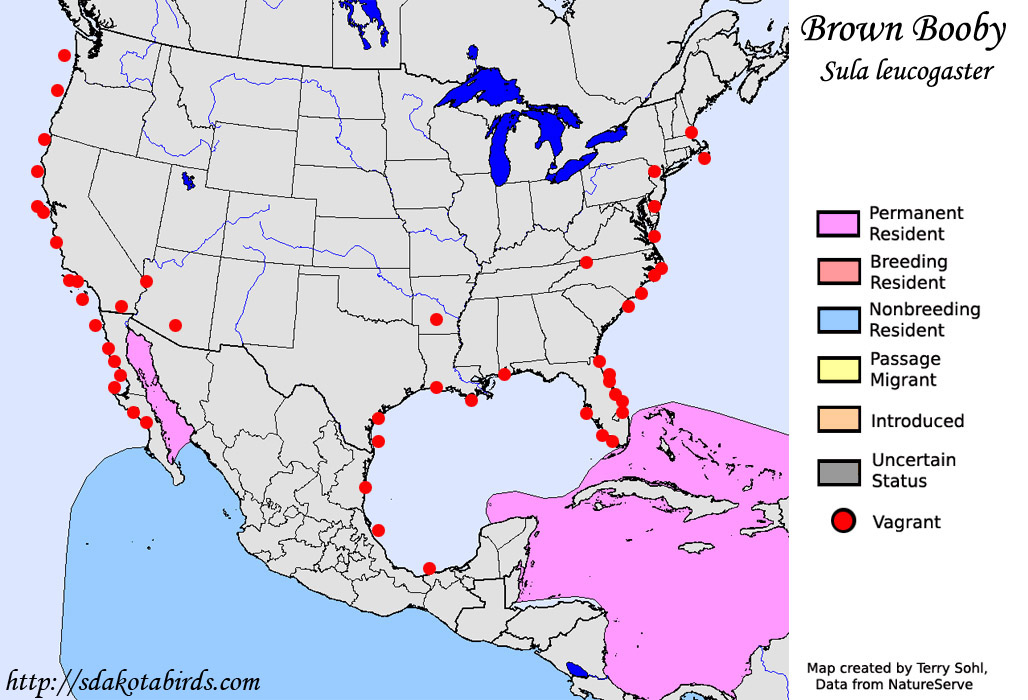For the first time ever perhaps, I woke up before my alarm and was on the road by 4:15 AM. After a brief rendezvous with Ross Wood, Brett Fried, and Barb Charlton in Hamilton, we were on our way to Fort Erie. When we arrived at Mather Park, it was still dark as sunrise was not for another hour. We set up our scopes, trained them on the metal platform where the Brown Booby had appeared to roost the previous evening, and as the morning sky lightened, we searched for the brown and white seabird with the big yellow bill. About a hundred Demon Pterodactyls (a.k.a. Double-crested Cormorants) were on the structure, but no Brown Booby.
More and more birders arrived, and eventually there were 40 to 50 people present, most with their eyes trained through their spotting scopes. We were facing east so the morning sun decreased visibility substantially, especially in the direction of Erie Basin Marina across the river in Buffalo where hundreds of cormorants were milling about.
Later in the morning, we received word that the birders on the New York side of the river had watched the Brown Booby fly in around 8:30 AM at the Erie Basin Marina, then continue to fly around and give crippling looks for 15 minutes before leaving! Somehow everyone on the Ontario side had missed seeing it (I'm blaming the glare from the sun). This was frustrating, but good news at least. The bird was still in the area.
As the day wore on, birders came and left and the attention level of many started to dwindle. There were not many interesting birds to look at, and one can only look at cormorants for so long before getting annoyed with them. Two Wild Indigo Duskywings were seen - a relatively late date.
It was around 1:30 in the afternoon when the bird was found. Few birders were actually scanning the river at this point - perhaps only 3 or 4 of us. As I scanned to the north, Ron Ridout suddenly called out that he had the bird in flight to the south! Immediately, about 40 pairs of eyes were frantically trying to get on the bird. Almost as quickly as it was seen, it disappeared into the mass of cormorants loafing on Donnelly's Pier. Two more times the bird flew before landing again on the pier. After a tense few minutes (I only had brief looks as the bird landed, and nothing definitive), Alan Wormington called out that the bird was flying again, and this time nearly everyone got on it. It lazily headed downriver at a surprising pace given the apparent "laziness" of its flight style. I cranked the scope up to 60x magnification and had pretty decent looks at it as it headed towards the Peace Bridge. Before reaching the bridge, it turned around and flew directly back to Donnelly's Pier, giving all of us good looks at it in flight!
The bird landed on the pier (in sight), prompting numerous phone calls to get all the remaining birders in the area to come to Mather Park to see the bird. The bird remained somewhat elusive on the pier, with pesky cormorants often standing in the way of the Brown Booby. Nonetheless, any tension felt by all the birders was gone. People were laughing and joking, ecstatic to have seen such a rarity for Ontario.
We ended up staying nearly til dark watching the bird on the pier and waiting for it to fly again. It never did, but we were able to study the bird as it preened, walked around, had a brief tussle with a cormorant, and slept. The distance between where we were standing and the end of Donnelly's Pier is approximately 2 km, so while views through the scope were sufficient, photography was more or less useless. Here is an uncropped photo of the pier, taken with a 420 mm lens.
And a cropped iPhone photo through the scope. My scope was already zoomed to 60x magnification for this photo. The brown pixel beside the white pixel is the bird. Or maybe not. Whatever it is, I'm sending in this photo to the OBRC as evidence of the Brown Booby!
 |
| Brown Booby - across from Fort Erie, ON |
It has been a fantastic few days of Sulidae watching in Ontario. First the adult Northern Gannet on October 5, and then the adult Brown Booby on October 8. Is it too much to ask for a Blue-footed Booby somewhere this weekend?













































.jpg)

.jpg)